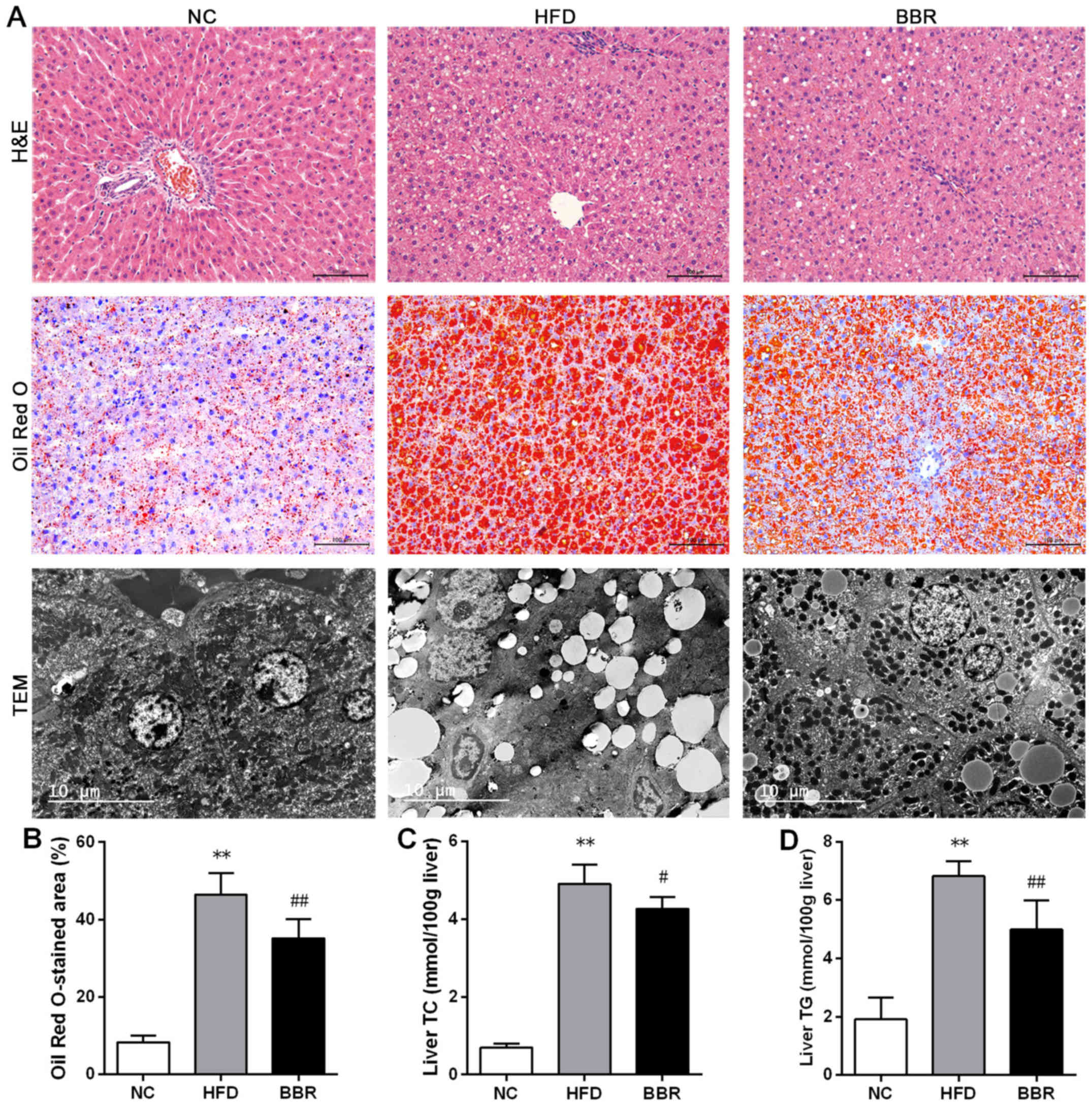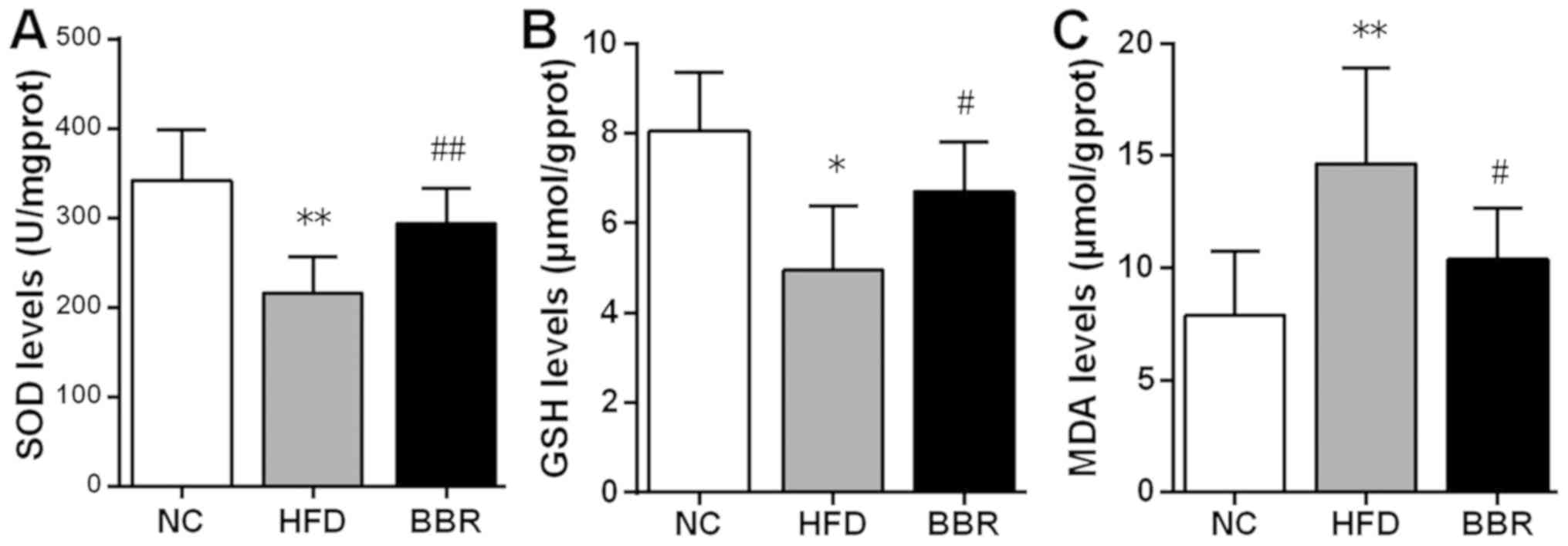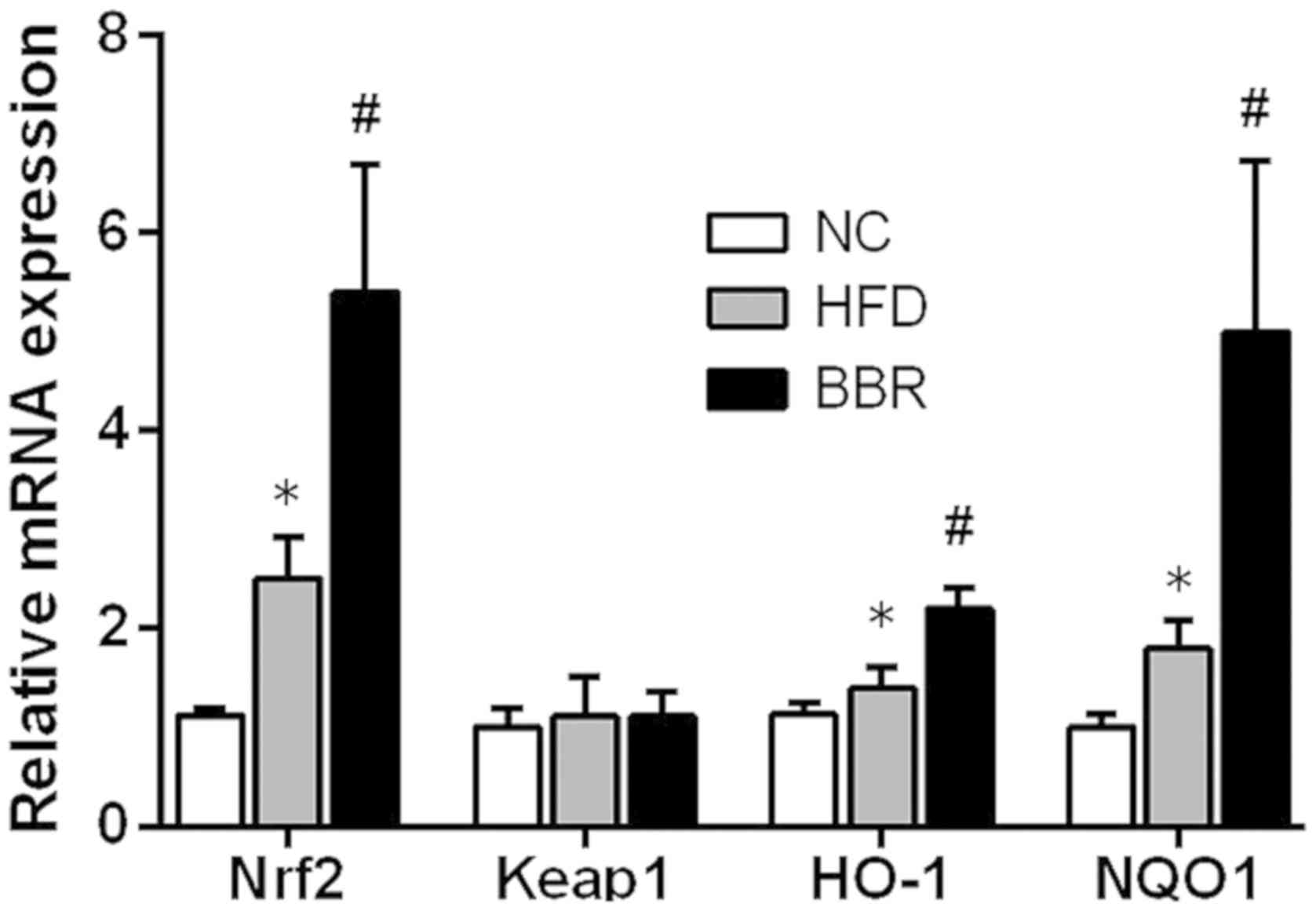|
1
|
Chalasani N, Younossi Z, Lavine JE, Diehl
AM, Brunt EM, Cusi K, Charlton M and Sanyal AJ: The diagnosis and
management of non-alcoholic fatty liver disease: Practice Guideline
by the American Association for the Study of Liver Diseases,
American College of Gastroenterology, and the American
Gastroenterological Association. Hepatology. 55:2005–2023. 2012.
View Article : Google Scholar : PubMed/NCBI
|
|
2
|
Than NN and Newsome PN: A concise review
of non-alcoholic fatty liver disease. Atherosclerosis. 239:192–202.
2015. View Article : Google Scholar : PubMed/NCBI
|
|
3
|
Farrell GC and Larter CZ: Nonalcoholic
fatty liver disease: From steatosis to cirrhosis. Hepatology. 43 (2
Suppl 1):S99–S112. 2006. View Article : Google Scholar : PubMed/NCBI
|
|
4
|
Musso G, Cassader M and Gambino R:
Non-alcoholic steatohepatitis: Emerging molecular targets and
therapeutic strategies. Nat Rev Drug Discov. 15:249–274. 2016.
View Article : Google Scholar : PubMed/NCBI
|
|
5
|
Videla LA, Rodrigo R, Araya J and
Poniachik J: Insulin resistance and oxidative stress
interdependency in non-alcoholic fatty liver disease. Trends Mol
Med. 12:555–558. 2006. View Article : Google Scholar : PubMed/NCBI
|
|
6
|
Friedman SL, Neuschwander-Tetri BA,
Rinella M and Sanyal AJ: Mechanisms of NAFLD development and
therapeutic strategies. Nat Med. 24:908–922. 2018. View Article : Google Scholar : PubMed/NCBI
|
|
7
|
Sakaida I and Okita K: The role of
oxidative stress in NASH and fatty liver model. Hepatol Res.
33:128–131. 2005. View Article : Google Scholar : PubMed/NCBI
|
|
8
|
Rolo AP, Teodoro JS and Palmeira CM: Role
of oxidative stress in the pathogenesis of nonalcoholic
steatohepatitis. Free Radical Bio Med. 52:59–69. 2012. View Article : Google Scholar
|
|
9
|
Kaspar JW, Niture SK and Jaiswal AK:
Nrf2:INrf2 (Keap1) signaling in oxidative stress. Free Radical Bio
Med. 47:1304–1309. 2009. View Article : Google Scholar
|
|
10
|
Vomhof-DeKrey EE and Picklo MJ Sr: The
Nrf2-antioxidant response element pathway: A target for regulating
energy metabolism. J Nutr Biochem. 23:1201–1206. 2012. View Article : Google Scholar : PubMed/NCBI
|
|
11
|
Chambel SS, Santos-Goncalves A and Duarte
TL: The dual role of Nrf2 in nonalcoholic fatty liver disease:
Regulation of antioxidant defenses and hepatic lipid metabolism.
Biomed Res Int 2015. 5971342015.
|
|
12
|
Tang W, Jiang YF, Ponnusamy M and Diallo
M: Role of Nrf2 in chronic liver disease. World J Gastroentero.
20:13079–13087. 2014. View Article : Google Scholar
|
|
13
|
Bataille AM and Manautou JE: Nrf2: A
potential target for new therapeutics in liver disease. Clin
Pharmacol Ther. 92:340–348. 2012. View Article : Google Scholar : PubMed/NCBI
|
|
14
|
Yin J, Zhang H and Ye J: Traditional
chinese medicine in treatment of metabolic syndrome. Endocr Metab
Immune Disord Drug Targets. 8:99–111. 2008. View Article : Google Scholar : PubMed/NCBI
|
|
15
|
Wang C, Li J, Lv X, Zhang M, Song Y, Chen
L and Liu Y: Ameliorative effect of berberine on endothelial
dysfunction in diabetic rats induced by high-fat diet and
streptozotocin. Eur J Pharmacol. 620:131–137. 2009. View Article : Google Scholar : PubMed/NCBI
|
|
16
|
Kong W, Wei J, Abidi P, Lin M, Inaba S, Li
C, Wang Y, Wang Z, Si S, Pan H, et al: Berberine is a novel
cholesterol-lowering drug working through a unique mechanism
distinct from statins. Nat Med. 10:1344–1351. 2004. View Article : Google Scholar : PubMed/NCBI
|
|
17
|
Wang Y, Campbell T, Perry B, Beaurepaire C
and Qin L: Hypoglycemic and insulin-sensitizing effects of
berberine in high-fat diet- and streptozotocin-induced diabetic
rats. Metabolism. 60:298–305. 2011. View Article : Google Scholar : PubMed/NCBI
|
|
18
|
Mo C, Wang L, Zhang J, Numazawa S, Tang H,
Tang X, Han X, Li J, Yang M, Wang Z, et al: The crosstalk between
Nrf2 and AMPK signal pathways is important for the
anti-inflammatory effect of berberine in LPS-stimulated macrophages
and endotoxin-shocked mice. Antioxid Redox Sign. 20:574–588. 2014.
View Article : Google Scholar
|
|
19
|
Liu Y, Zhang L, Song H and Ji G: Update on
berberine in nonalcoholic Fatty liver disease. Evid Based
Complement Alternat Med 2013. 3081342013.
|
|
20
|
Yang J, Ma XJ, Li L, Wang L, Chen YG, Liu
J, Luo Y, Zhuang ZJ, Yang WJ, Zang SF and Shi JP: Berberine
ameliorates non-alcoholic steatohepatitis in ApoE(−/-) mice. Exp
Ther Med. 14:4134–4140. 2017.PubMed/NCBI
|
|
21
|
Yang QH, Hu SP, Zhang YP, Xie WN, Li N, Ji
GY, Qiao NL, Lin XF, Chen TY and Liu HT: Effect of berberine on
expressions of uncoupling protein-2 mRNA and protein in hepatic
tissue of non-alcoholic fatty liver disease in rats. Chin J Integr
Med. 17:205–211. 2011. View Article : Google Scholar : PubMed/NCBI
|
|
22
|
Wu D, Wen W, Qi CL, Zhao RX, Lü JH, Zhong
CY and Chen YY: Ameliorative effect of berberine on renal damage in
rats with diabetes induced by high-fat diet and streptozotocin.
Phytomedicine. 19:712–718. 2012. View Article : Google Scholar : PubMed/NCBI
|
|
23
|
Gomes AP, Duarte FV, Nunes P, Hubbard BP,
Teodoro JS, Varela AT, Jones JG, Sinclair DA, Palmeira CM and Rolo
AP: Berberine protects against high fat diet-induced dysfunction in
muscle mitochondria by inducing SIRT1-dependent mitochondrial
biogenesis. Biochim Biophys Acta 1822. 185–195. 2012.
|
|
24
|
Livak KJ and Schmittgen TD: Analysis of
relative gene expression data using real-time quantitative PCR and
the 2(-Delta Delta C(T)) method. Methods. 25:402–408. 2001.
View Article : Google Scholar : PubMed/NCBI
|
|
25
|
Jensen VS, Hvid H, Damgaard J, Nygaard H,
Ingvorsen C, Wulff EM, Lykkesfeldt J and Fledelius C: Dietary fat
stimulates development of NAFLD more potently than dietary fructose
in Sprague-Dawley rats. Diabetol Metab Syndr. 10:42018. View Article : Google Scholar : PubMed/NCBI
|
|
26
|
Malaguarnera M, Di Rosa M, Nicoletti F and
Malaguarnera L: Molecular mechanisms involved in NAFLD progression.
J Mol Med (Berl). 87:679–695. 2009. View Article : Google Scholar : PubMed/NCBI
|
|
27
|
Day CP and James OF: Steatohepatitis: A
tale of two ‘hits’? Gastroenterology. 114:842–845. 1998. View Article : Google Scholar : PubMed/NCBI
|
|
28
|
Zhu R, Wang Y, Zhang L and Guo Q:
Oxidative stress and liver disease. Hepatol Res. 42:741–749. 2012.
View Article : Google Scholar : PubMed/NCBI
|
|
29
|
Tanaka Y, Aleksunes LM, Yeager RL, Gyamfi
MA, Esterly N, Guo GL and Klaassen CD: NF-E2-related factor 2
inhibits lipid accumulation and oxidative stress in mice fed a
high-fat diet. J Pharmacol Exp Ther. 325:655–664. 2008. View Article : Google Scholar : PubMed/NCBI
|
|
30
|
Xu W, Shao L, Zhou C, Wang H and Guo J:
Upregulation of Nrf2 Expression in Non-Alcoholic Fatty Liver and
Steatohepatitis. Hepatogastroenterology. 58:2077–2080. 2011.
View Article : Google Scholar : PubMed/NCBI
|
|
31
|
Okada K, Warabi E, Sugimoto H, Horie M,
Gotoh N, Tokushige K, Hashimoto E, Utsunomiya H, Takahashi H, Ishii
T, et al: Deletion of Nrf2 leads to rapid progression of
steatohepatitis in mice fed atherogenic plus high-fat diet. J
Gastroenterol. 48:620–632. 2013. View Article : Google Scholar : PubMed/NCBI
|
|
32
|
Meakin PJ, Chowdhry S, Sharma RS, Ashford
FB, Walsh SV, McCrimmon RJ, Dinkova-Kostova AT, Dillon JF, Hayes JD
and Ashford ML: Susceptibility of Nrf2-Null mice to steatohepatitis
and cirrhosis upon consumption of a high-fat diet is associated
with oxidative stress, perturbation of the unfolded protein
response, and disturbance in the expression of metabolic enzymes
but not with insulin resistance. Mol Cell Biol. 34:3305–3320. 2014.
View Article : Google Scholar : PubMed/NCBI
|
|
33
|
Li Z, Geng Y, Jiang J and Kong W:
Antioxidant and anti-inflammatory activities of berberine in the
treatment of diabetes mellitus. Evid-Based Compl Alt 2014.
2892642014.
|
|
34
|
Yin J, Xing H and Ye J: Efficacy of
berberine in patients with type 2 diabetes mellitus. Metabolism.
57:712–717. 2008. View Article : Google Scholar : PubMed/NCBI
|
|
35
|
Chang X, Yan H, Fei J, Jiang M, Zhu H, Lu
D and Gao X: Berberine reduces methylation of the MTTP promoter and
alleviates fatty liver induced by a high-fat diet in rats. J Lipid
Res. 51:2504–2515. 2010. View Article : Google Scholar : PubMed/NCBI
|
|
36
|
Zhou J, Zhou S, Tang J, Zhang K, Guang L,
Huang Y, Xu Y, Ying Y, Zhang L and Li D: Protective effect of
berberine on beta cells in streptozotocin- and
high-carbohydrate/high-fat diet-induced diabetic rats. Eur J
Pharmacol. 606:262–268. 2009. View Article : Google Scholar : PubMed/NCBI
|
|
37
|
Hsu YY, Chen CS, Wu SN, Jong YJ and Lo YC:
Berberine activates Nrf2 nuclear translocation and protects against
oxidative damage via a phosphatidylinositol 3-kinase/Akt-dependent
mechanism in NSC34 motor neuron-like cells. Eur J Pharm Sci.
46:415–425. 2012. View Article : Google Scholar : PubMed/NCBI
|
|
38
|
Yates MS, Tran QT, Dolan PM, Osburn WO,
Shin S, McCulloch CC, Silkworth JB, Taguchi K, Yamamoto M, Williams
CR, et al: Genetic versus chemoprotective activation of Nrf2
signaling: Overlapping yet distinct gene expression profiles
between Keap1 knockout and triterpenoid-treated mice.
Carcinogenesis. 30:1024–1031. 2009. View Article : Google Scholar : PubMed/NCBI
|




















